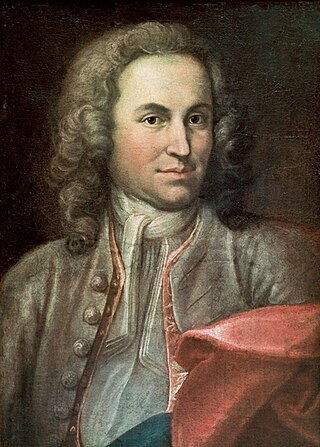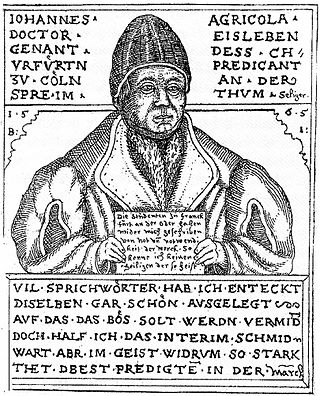Related Research Articles

Nach dir, Herr, verlanget mich, BWV 150, is an early church cantata by Johann Sebastian Bach composed for an unknown occasion. It is unique among Bach's cantatas in its sparse orchestration and in the independence and prominence of the chorus, which is featured in four out of seven movements. The text alternates verses from Psalm 25 and poetry by an unknown librettist. Bach scored the work for four vocal parts and a small Baroque instrumental ensemble of two violins, bassoon and basso continuo.
The Bach-Werke-Verzeichnis is a catalogue of compositions by Johann Sebastian Bach. It was first published in 1950, edited by Wolfgang Schmieder. The catalogue's second edition appeared in 1990. An abbreviated version of that second edition, known as BWV2a, was published in 1998.

Gottfried Heinrich Stölzel was a prolific German composer of the Baroque era. Stölzel was an accomplished German stylist who wrote a good many of the poetic texts for his vocal works.

Gott ist mein König, BWV 71, is a cantata by Johann Sebastian Bach written in Mühlhausen when the composer was 22 years old. Unusually for an early cantata by Bach, the date of first performance is known: at the inauguration of a new town council on 4 February 1708.

The cantatas composed by Johann Sebastian Bach, known as Bach cantatas, are a body of work consisting of over 200 surviving independent works, and at least several dozen that are considered lost. As far as known, Bach's earliest cantatas date from 1707, the year he moved to Mühlhausen, although he may have begun composing them at his previous post in Arnstadt. Most of Bach's church cantatas date from his first years as Thomaskantor and director of church music in Leipzig, a position which he took up in 1723.

Johann Sebastian Bach composed the church cantata Ich hatte viel Bekümmernis, BWV 21 in Weimar, possibly in 1713, partly even earlier. He used it in 1714 and later for the third Sunday after Trinity of the liturgical year. The work marks a transition between motet style on biblical and hymn text to operatic recitatives and arias on contemporary poetry. Bach catalogued the work as e per ogni tempo, indicating that due to its general theme, the cantata is suited for any occasion.

Jesus nahm zu sich die Zwölfe, BWV 22, is a church cantata by Johann Sebastian Bach composed for Quinquagesima, the last Sunday before Lent. Bach composed it as an audition piece for the position of Thomaskantor in Leipzig and first performed it there on 7 February 1723.

Aus tiefer Not schrei ich zu dir, BWV 38, is a church cantata by Johann Sebastian Bach. He composed the chorale cantata in Leipzig in 1724 for the 21st Sunday after Trinity and first performed it on 29 October 1724.

Aus der Tiefen rufe ich, Herr, zu dir, BWV 131, is a church cantata by the German composer Johann Sebastian Bach. It was composed in either 1707 or 1708, which makes it one of Bach's earliest cantatas. Some sources suggest that it could be his earliest surviving work in this form, but current thinking is that there are one or two earlier examples.

Johann Ernst Bach was a German composer of the Classical Period. He was the son of Johann Bernhard Bach.

Johann Sebastian Bach composed the church cantata Ich ruf zu dir, Herr Jesu Christ, BWV 177. He wrote the chorale cantata in Leipzig for the fourth Sunday after Trinity and first performed it on 6 July 1732. The cantata text is formed by the unchanged five stanzas of Johann Agricola's hymn.

Johann Sebastian Bach composed the church cantata Barmherziges Herze der ewigen Liebe, BWV 185 in Weimar for the fourth Sunday after Trinity and first performed it on 14 July 1715.

Der Herr denket an uns, BWV 196, is a cantata by Johann Sebastian Bach. The early church cantata, possibly for a wedding, is difficult to date, but is generally considered to be an early work on stylistic grounds. The text is a passage from Psalm 115, assuring of God's blessing, especially for children. Scholars have suggested the work may have been written for the wedding of Johann Lorenz Stauber, the minister in Dornheim who had married Bach and his first wife there in 1707, and Regina Wedemann, an aunt of Bach's wife, on 5 June 1708.

Johann Sebastian Bach started composing cantatas around 1707, when he was still an organist in Arnstadt. The first documented performances of his work took place in Mühlhausen, where he was appointed in 1708.
"Herr Jesu Christ, du höchstes Gut" is the beginning of two Lutheran hymns. One is a penitential hymn, written in 1588 by Bartholomäus Ringwaldt, who possibly also created the melody. The other is an anonymous communion hymn, probably based on the former, which appeared first in 1713. Johann Sebastian Bach's used the penitential hymn several times, including the chorale cantata Herr Jesu Christ, du höchstes Gut, BWV 113, based on the hymn.
"Aus der Tiefen rufe ich, Herr, zu dir. Herr, höre meine Stimme ..." is a German translation of the opening words of Psalm 130 ("Out of the depths have I cried unto thee, O Lord. Lord, hear my voice, ..."). Aus der Tiefe(n) may also refer to:
"Aus der Tiefen rufe ich, Herr, zu dir" is a German hymn with a text by Georg Christoph Schwämlein. The opening lines of the hymn stay close to those of Psalm 130, while most stanzas of the hymn are written from a Christian perspective. It was first published, with its own hymn tune, in the Nürnberg hymnal of 1676. Gottfried Vopelius published it with a new hymn tune in the 1682 Neu Leipziger Gesangbuch, p. 936. From 1699 to 1738 the hymn was published with four more new melodies.
References
- ↑ Johann Sebastian Bach Composer Fugue in G-, BWV131a classicalarchives.com
- ↑ "Fugue, g BWV 131a". Bach Digital . Leipzig: Bach Archive; et al. 2018-07-07.
- ↑ "Aus der Tiefen rufe ich, Herr, zu dir BWV 131". Bach Digital . Leipzig: Bach Archive; et al. 2019-03-11.
- ↑ Bach-Gesellschaft Ausgabe, Vol. 38. Leipzig: Breitkopf und Härtel, 1891.
- ↑ Smith, Craig. "Cantata 131; Programme Notes". Emmanuel Music . Retrieved September 3, 2012.